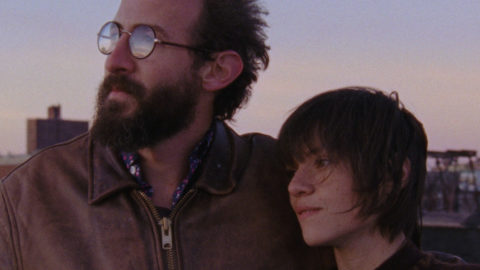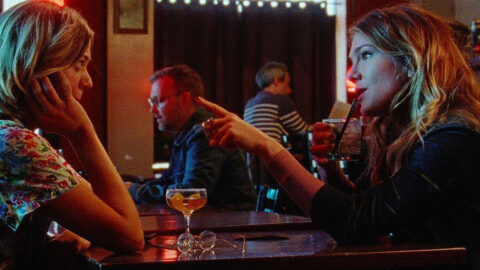Sundance Interview: Rachel Rossin
“The concept of entropy is central to Rossin’s body of work, including The Sky is a Gap, whose stated inspiration, immediately decipherable in the wall wrap of the space in the main ‘VR Palace’ showcase, is the series of slow-motion demolitions of consumer goods that caps Michelangelo Antonioni’s Zabriskie Point,” Nick Pinkerton writes in his Inside Stories article in our March/April 2017 issue. Pinkerton spoke with Rossin at Sundance for Film Comment.
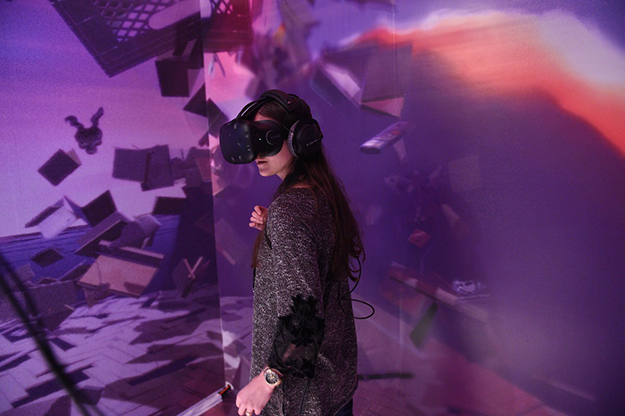
Installation view of The Sky is a Gap
The stated launching point for the piece is the climax of Zabriskie Point. What was your first encounter with the film?
Zabriskie Point and Blow-Up are just sort of fixtures in the film and art world, sort of the community that I’m in. It’s just something that’s canonized already, you know? Whatever Zabriskie Point is as a film is secondary to it being canonized already… So I’ve been aware of the film for a really long time, but I’d never really done a piece about it. But I came across the end sequence again, probably last year, right around the time when the political climate started getting really scary, and I rewatched the film, and I was like, “Oh my God, you can just see what he was intending to do, and then what actually came out of it is really interesting.” I was working on the script for this piece like a year ago, and I knew that I wanted to move space and time, I wanted to move time and space. I was working on what would be the content of that process, what would be the content of that script. I had figured out that I wanted to do that, but I hadn’t figured out what the content was. And I came across that ending sequence of Zabriskie Point, and rewatched the film, and realized how important the film could be to the content of this sort of thought experiment, and how that relates to Schrödinger’s equation, those types of thought experiments. And just how there are these parallels between the counterculture movements in that time period and now, both aesthetically and politically.
When people talk about the finale of Zabriskie Point it’s very often talked about as an allegory for American wastefulness, but it’s also very tied into the Cold War, and this sort of A-bomb aesthetic. Not that the two are mutually exclusive from one another—nuclear proliferation is waste. So why did this imagery seem like it was something you needed to dig into now?
I think what I find so poignant about that finale is what he was working on within it. It was all shot in this way, using the telephoto lens, that you can really… You could interpret it as having a certain cynicism, because obviously you’re blowing up a bunch of things, you’re destroying a bunch of things. But it also feels very loving, and obviously it’s very beautiful. What I found interesting was that you can do both, you know? You can hold things close to you, but you can also watch them being dissolved. That’s when I was completely convinced, when I located this feeling of things being very precious just as they’re vaporized.
We’re in a time in history where we just keep hearing about how unprecedented everything is, but it’s very much like what was happening in the late 1960s and early 1970s in a way that… This is kind of the closest thing we have to this. So you have this incredibly cathartic, chaotic ending to a movie that is very curiously conceived, it feels sort of confused… Its heart is so good, but it itself is confused. So that does feel really appropriate for a lot of aspirational countercultural movements which, for better or for worse, are confronted with the worst things and then… It’s not like they’re impotent or anything like that, but like, Occupy Wall Street is a good example. They end up being primal screams, over and over again. But it’s interesting that you have that in common with what was happening then, which was just complete chaos and very confusing. And all we have to do is take these things that we adore or act as time capsules of the period that we’re in and just completely obliterate them. It’s not about nihilism; I think that’s very important. I would argue against Antonioni’s end being nihilistic. I think it’s anything but. It’s about levels of escapism, levels of intimacy, and trying to figure out what defines you in moments of chaos, and how these elements collide… And it’s very much a time capsule, too.
I wonder if you could talk a little bit about the process of collating and curating the objects that fill up the different stages or worlds in your piece. I had a fairly quick walk-through which perhaps wasn’t time enough for me to process what the organizing concept was that was bringing together these various disparate objects. What was your organizing principle?
Some of those are just recreations of my studio, my home and studio life in the present… It’s all just things that felt of this time, and sometimes things of this time obviously bring in things from the past. There’s a kind of VR headset at almost every level. The Avatar movie shows up a few different times, there’s the books… It’s really just things that I felt were important, or important through their lack of importance. They’re all intentional. There’s nothing there that’s not supposed to be there. Sometimes things are important by their very ubiquity. There’s things like birthday cards, there’s that Ram Dass book, which I think is very funny, I’ve been seeing it around a lot, just like on people’s coffee tables. There’s The Gay Science by Nietzsche, which is filled with its own paradoxes.
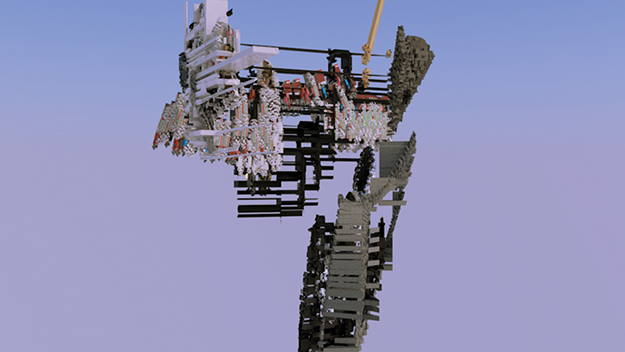
The Sky is a Gap
Would it be safe to say that even if they’re not all objects or things that you define as personally meaningful, that somehow there is an autobiography or something like that in the objects?
Yeah, definitely. That’s definitely what they are.
I wonder, being somebody who has absolutely no grasp on what the actual nuts and bolts of putting something like this together is, could you describe a little what the actual creation of the piece entailed in layman’s terms?
The approach is more like how you’d approach designing a video game. So what that means is first figuring out how to… The script behind the images is pretty simple. I’m trying to figure out how to move space and time, and so that just meant having conversations with other programmers. Just workshopping it. And then once the main logic was done, once that part of the script was done, from there it was just creating the assets. The assets meaning the objects and the animations that go with them. So the explosions are all done by simulations. We’re using the same software that’s used in any CG movie that’s made now. We’re using the same logic, the same physics systems. So using software for movies—sometimes it’s used in video games, but usually it’s used for movies, like big explosions—and using that, recording the data, and then bringing it into a video game engine, and then putting the logic on top of the simulations. So it’s the same way you’d do it for bringing something like that into a film, the difference being that time here isn’t 2D, time is 3D, and the logic is interactive. Which is really what it is—it’s like you’re scrubbing time forwards and backwards with your body. People in film intuitively understand what that means, especially editors, if you’re scrubbing time forwards and backwards, the difference being we think of time as a 2D thing—which I think is even more interesting—but we think of time as a 2D thing instead of a 3D thing. Obviously time is a 3D thing.
And there are these little pockets of sound that are sort of Easter egged around the space, and it’s very interesting. The way I described it to people is that you feel like your body is a stylus on a record player or something, where you’re kind of contorting yourself in order to get these cryptic messages which are always just on the cusp of audibility, these little broken phrases which almost reminded me in a weird way of Ed Atkins’s work.
Oh yeah. Of course, I like his work..
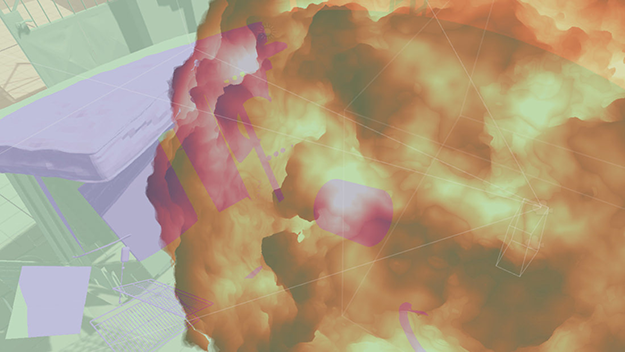
The Sky is a Gap
These cryptic bits of phrasing…
Yeah, that was an interesting thing because it’s so… Just like time is 3D, sound is 3D in the space as well. If you’re able to move 3D sound as well as space—that was an interesting and more complex thing to figure out. Because how do you build the logic for that? In the piece that I’m making now that has more space, I explore that some more. You could find the way to get that loop of little sound pieces to play in sequence, but because the sound was traveling in the opposite direction, you’d have to walk backwards while moving at the same speed that the object is moving. That’s an interesting thing to give to people. How you can trick the system into playing it at one to one, and how challenging do you make that [for the viewer]? So my voice is in it, and then voices of people that I love are in there, there’s like the “You’ve got mail!” from AOL in there, political leaders. It’s just sounds that are autobiographical. Sounds, and objects, and people.
I felt like the piece was very much an outlier among the works at the VR Palace. A lot of the work seemed to be very dedicated to trying to implement storytelling technique through VR, and it seems that there’s an ongoing fumbling to figure out what preexisting art form this technology has the most affinity to, and what it can draw from the most, be it immersive theater, or installation art, or narrative cinema, or experimental cinema. And obviously you’re drawing on a certain cinematic precedent, but how are you thinking about the manner in which this is or is not like a preexisting medium?
I find a lot of that discourse to be very… Not only does it feel oppressive and boring but it’s also… There are all these rules about what we’re doing, which I think is a terrible thing. This is a brand-new medium. Well, the medium has been around, obviously, for a very long time, but it’s actually feasible to make things for the medium now, so it’s brand-new according to that. So a brand-new medium, and not even a year goes by with people working in it in large numbers and I’m coming across people telling me what the rules are for it. I find that absolutely to be totally wrongheaded. I still keep seeing that. It’s exactly what you’re saying. I think it’s interesting that people are trying to squeeze what they already know into this new medium, and adopting stuff from other mediums, into something which is completely different in the way that it can function, and just logically, how it is. I think maybe it’s also that there’s not a lot of people that make films and also make video games, and I think that virtual reality is going to bring more of that to the table, both of those skill sets. A lot of good virtual reality would be… a lot of films that could exist in virtual reality would actually be made more like cut-scenes in a video game or something, like interactive cut-scenes. Because I come from a programming background, I think maybe I have an advantage. I wasn’t trying to make films for VR. I’m just trying to make a good art piece, something that could exist in 360.
I wonder if you could talk a little bit about your background in both art and programming.
I went to Florida State. I studied film for a bit there, but mostly art.
And in your gallery exhibitions you’ve combined plastic, physical, IRL artworks—that is, paintings—and VR, had both coexisting in one and the same show.
I did a show a year ago called Lossy which brought together virtual reality and painting, oil painting. “Lossy” is a term that’s used to talk about image compression and data compression. There’s really two types of compression, lossless and lossy. A lossless codec stays perfect forever. And lossy, every time you change it, every time you resize it, it’s like it has entropy sort of built into it, entropy exists in order to save space. So that was an interesting idea of bringing it into the relationship, looking at how virtual reality exists through constant referencing of the physical world. Obviously it references the physical world because it comes from the physical world, but it’s talking about how to make virtual realities from things from the physical world, and then bringing those things from the physical world, meaning the paintings, back into the virtual reality. There’s an interesting thing to explore. So that was the first time I wanted to do that. And that just felt very natural to me, because it felt like that’s what I’ve been trying to do, even when I was growing up. The first time I started using a computer I was six, and I started learning programming when I was eight so… This felt like something I never really got to put into a physical space, and when I did, it just felt very true. Like almost similar to cinema verité. This feels like I’m trying to do something that I have talked about.
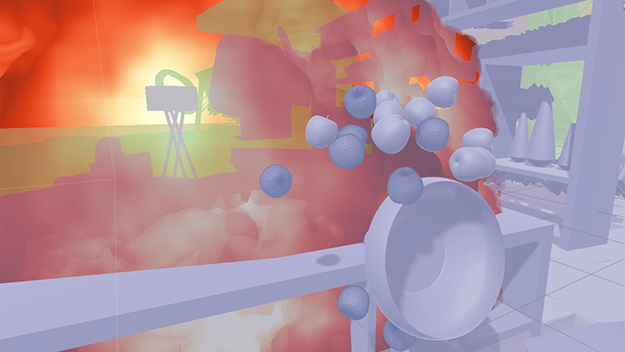
The Sky is a Gap
You use a word in talking about the show Lossy which I think is interesting to think about in terms of The Sky Is a Gap, which is “entropy.” It seems like, maybe it’s a stretch, but there’s a kind of through-line between these two pieces of work. Certainly with regards to the imagery that exists in The Sky Is a Gap, which is literally things falling apart, things coming to pieces.
Yes. Robert Smithson wrote an essay called Entropy and the New Monuments. I was reading that when I was working on both of these pieces, actually, and it’s one of the things that I go back to. It just contextualizes the relationship we have with entropy in a beautiful way. I think that’s one of the through-lines for my work. I keep coming home to it. I think that’s appropriate for both of those works. I think it’s almost unconscious, the influence.
In talking about Dan Flavin’s work, Smithson says that his work is “A part of time rather than space,” which I thought very interesting when thinking about The Sky Is a Gap, which is very centrally concerned with that interrelation.
Yeah. “Time becomes a place minus motion.” Yeah, that’s actually so beautiful because you’re in this moment… I went and saw the Dan Flavin installation in Houston, the last thing he did. These pieces, these columns of light, are flanking the gallery, it’s almost like an homage to two-point perspective, these columns of light are shooting into the distance. All I wanted to do was run past them, like forwards and backwards, so I was like running from one side of the gallery to the next. The space was completely empty. I just wanted to figure out how he found a way to space these columns in a different relationship to one another. When I first started working on this piece, what I wanted was to be able to use something on the scale of, like, a football field. I wanted one-to-one with space and time, only moving extremely fast when you’re running it at that speed. Unconsciously, that must have been in there, that experience of wanting to activate Dan Flavin’s work.
I’ve seen you use the phrase “entropic moderator” before, which I like very much. I wonder if you could expand on what that means?
Okay, I’ll try! I think that’s what our… your role as a human being is that. And I think that the core of my favorite experiences have that as their tether to reality. It’s what we’re doing every day. When we’re experiencing… I’ll get too far out, maybe, if I go on. I think if I say too much, I’ll kill it.
It’s interesting that you say it’s at the core of your favorite experiences because generally, entropy is thought of as kind of tied to pessimism. It’s very Henry Adams, very things fall apart. You seem to be positing it as something… else.
Yeah, I know. That’s like the core sentiment, the reason that things are sweet is because they end. Finding the sweetness is figuring out how to negotiate, or moderate, how long you can stretch out the inevitable.
Nick Pinkerton is a regular contributor to Film Comment and a member of the New York Film Critics Circle.



